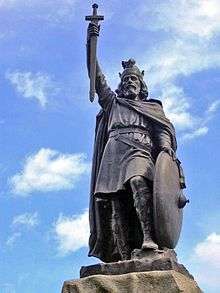Treaty of Wedmore
The Peace of Wedmore is a term used by historians for an event referred to by the monk Asser in his Life of Alfred, outlining how in 878 the Viking leader Guthrum was baptised and accepted Alfred as his adoptive father. Guthrum agreed to leave Wessex and a "Treaty of Wedmore" (sometimes called the "Treaty of Chippenham") is often assumed by historians to have existed. No such treaty still exists. However, there is a document not specifically linked to Wedmore that is a Treaty of Alfred and Guthrum.
Sources and historical context

In 878 King Alfred of Wessex defeated a Viking army at the Battle of Edington. Guthrum, the Viking leader, retreated with the remnants of his army to their "stronghold", where Alfred besieged him. After fourteen days the Vikings "thoroughly terrified by hunger, cold and fear" sought peace and sent an emissary to Alfred.
Alfred accepted Guthrum's surrender. According to Asser, in his Life of Alfred, the Vikings gave Alfred peace hostages, and "swore in addition that they would leave his kingdom immediately, and Guthrum, their king, promised to accept Christianity and to receive baptism at King Alfred's hand; all of which he and his men fulfilled as they had promised."
Three weeks later Guthrum and thirty of his men came to Alfred at Aller, near Athelney, and there Guthrum was baptised, with Alfred accepting him as his adoptive son. Then, according to Asser:
As agreed Guthrum left Chippenham and moved to Cirencester. Following this Guthrum returned to East Anglia, where he ruled in what had been East Anglia, Essex and Eastern Mercia. Over time these lands became known as Danelaw. Eventually Wessex, under Alfred and his successors, conquered all of this land.
Misinterpretation and confusion

The only reference in the sources to any kind of treaty at Wedmore is the above quotation from Asser. All we know, therefore, is that it was at Wedmore that Guthrum accepted Alfred as his adoptive father and accepted the Christian faith. There was clearly an important element here of Alfred exercising his dominance; however, the source material provides no hint as to the wider implications of this in terms of territory or otherwise.
However, some misinterpretation appears to have arisen, probably from confusing what happened at Wedmore with the later Treaty of Alfred and Guthrum. This led to a "Treaty of Wedmore" as a defining point in Anglo-Saxon history, as suggested by the map. Whilst it is quite possible that land arrangements were discussed at Wedmore, or Aller, or elsewhere, following Edington, there is nothing in the sources to provide evidence for this.
Bibliography
- Simon Keynes and Michael Lapidge, Alfred the Great: Asser's Life of King Alfred and Other Contemporary Sources, (London: Penguin,1983)
- Frank Stenton, Anglo-Saxon England, 3rd edition, (Oxford: Oxford University Press, 1971), p257
External links
- Britannia History Peace of Wedmore